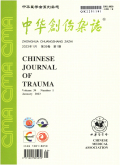Masquelet膜诱导技术治疗创伤性长骨骨缺损的效果
Efficacy of Masquelet membrane induction technique for traumatic long bone defects
摘要目的 探讨Masquelet膜诱导技术治疗创伤性长骨骨缺损的早期临床疗效.方法 采用回顾性病例系列研究分析2012年1月-2017年4月北部战区总医院收治的41例创伤性长骨骨缺损患者的临床资料,其中男36例,女5例;年龄15~70岁,平均38.2岁.骨缺损部位:股骨20例,胫骨19例,腓骨1例,尺骨1例.均采用Masquelet膜诱导技术分期治疗,Ⅰ期手术彻底清创,术中取分泌物行细菌培养,清创后平均骨缺损长度2.0~18.5 cm,平均6.9 cm.在骨缺损处填充抗生素骨水泥诱导生物膜形成.如术后细菌培养阳性,则再次行清创手术.6~12周后行Ⅱ期手术.术前行白细胞计数、C-反应蛋白(CRP)、降钙素原(PCT)、红细胞沉降率(ESR)等检查.术中行骨组织活检,彻底取出骨水泥占位器,骨缺损处植入自体松质骨及人工骨,并缝合诱导膜.记录骨缺损愈合时间,采用Paley骨折愈合评分标准对肢体功能进行评价.观察并发症情况,末次随访时复查炎性指标.结果 41例患者均获随访7 ~36个月,平均13.6个月.37例获得骨性愈合,Ⅰ期骨折愈合率为90%,愈合时间6~13个月,平均9个月.按Paley骨折愈合评分标准评价:优25例,良10例,可2例,差4例,优良率为85%.并发症包括1例浅部感染,通过换药方式获得痊愈;3例深部感染,其中1例截肢,2例选择其他治疗方式;3例因骨吸收再次行膜诱导技术治疗.末次随访时白细胞计数、CRP、PCT及ESR与术前比较,差异均有统计学意义(P<0.05).结论 Masquelet膜诱导技术治疗创伤性长骨骨缺损可促进骨折愈合,恢复肢体功能,减少并发症.
更多相关知识
abstractsObjective To investigate the early clinical efficacy of Masquelet membrane induction technique in the treatment of traumatic long bone defects.Methods A retrospective case series study was conducted to analyze the clinical data of 41 patients with traumatic long bone defects admitted to the General Hospital of the Northern Theater Command from January 2012 to April 2017.There were 36 males and five females,aged 15-70 years,with an average of 38.2 years.There were 20 patients with bone defect at the femur,19 at the tibia,one at the fibula,and one at the ulna.All patients received staged treatment using the Masquelet membrane induction technique.In stage Ⅰ surgery,thorough debridement was first performed,and the secretions were taken for bacterial culture.The average bone defect length after debridement was 6.9 cm (2.0-18.5 cm).The bone defect was filled with antibiotic bone cement to induce the biofilm formation.If the postoperative bacterial culture showed positive results,debridement surgery was performed again.Stage Ⅱ surgery was performed after 6-12 weeks.The white blood cell count,C-reactive protein (CRP),procalcitonin (PCT),erythrocyte sedimentation rate (ESR) were measured before the operation.During the operation,bone biopsy was performed,and the bone cement placeholder was completely removed.The autologous cancellous bone and artificial bone were implanted in the bone defect areas,and the induced membrane was sutured.The healing time of bone defects was recorded,and the Paley fracture healing scoring criteria were used to evaluate the limb function.The complications were observed.The inflammatory markers were reviewed at the last follow-up.Results All patients were followed up for 7-36 months with an average of 13.6 months.A total of 37 patients obtained bone healing.The fracture healing rate of stage Ⅰ was 90%,and the healing time was 6-13 months,with an average of 9 months.According to the Paley fracture healing scoring criteria,the results were excellent in 25 patients,good in 10,and fair in two patients,with the excellent and good rate of 85%.In terms of complications,one patient with superficial infection recovered after dressing change,three patients had deep infection,of which one patient was treated with amputation and two received other treatments,and three patients were treated with membrane induction again because of bone resorption.At the last follow-up,there were significant differences between preoperative and postoperative White blood cell count,CRP,PCT and ESR(P < 0.05).Conclusion For traumatic long bone defects,Masquelet membrane induction technique can promote fracture healing,restore limb function and reduce complications.
More相关知识
- 浏览445
- 被引24
- 下载548


相似文献
- 中文期刊
- 外文期刊
- 学位论文
- 会议论文



 换一批
换一批 换一批
换一批



